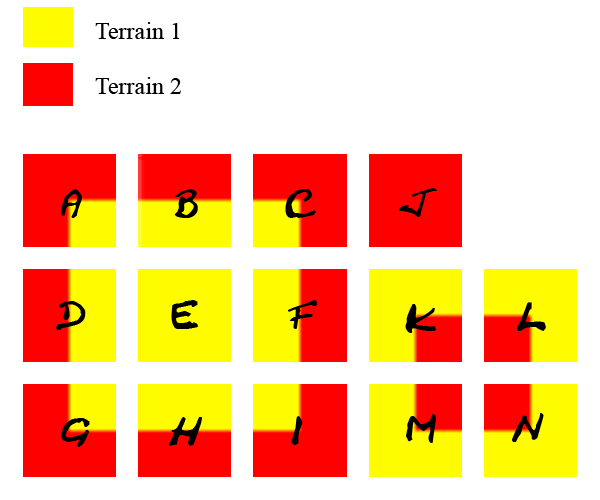Hey everyone,
As a lot of you know probably know, we do not have a auto-tiler that can can automatically places transition tiles on an Outpost 2 map. I've played with the mapper a fair amount and verified with others on mirc that the wells (tilesets) in Outpost 2 do not actually contain a full set of transition tilesets to play with. See the picture below for what I'm talking about.

Basically, we need transition tiles to line up in the same place between each tile. Outpost 2 sometimes has multiple transition tiles for the same transition, with each one lining up at a different spot on the map from each other. Sometimes the transition tile just doesn't exist.
In light of someday getting a more friendly mapper created, it would be nice to have a solid auto-tiler-placer that handled putting down transition tiles automatically.
I would like to document the current state of transition tiles in the game with the goal of determining exactly which transition tiles are missing. Before I put any time into it though, I wanted to ask around and see if anyone already has the data sitting around. If so, it would be great to post it here to reduce duplicating work. I know some people have looked into the problem before, I just don't know if they have anything useful written down.
Outpost 2 is capable of accepting more tilesets and individual tiles. I think we have plenty of space for more tilesets. If I remember correctly, there isn't room for very many new tiles though. Does someone happen to know how many more tiles we can add to the game, assuming all current tilesets are loaded into a map?
If we can create a new tileset containing the missing transition tiles and distribute it with the game without exceeding the allowed tile count, this would be ideal. I do have an idea on how to get around the limit but perhaps someone smarter than me on memory hacking could modify the limit to be higher through HxD/OllyDbg? Anyways, I figure we should count and see how many more tiles are needed before worrying about getting around/increasing the limit.
Once the tiles are identified, it would be nice to have an artist step forward to design the missing tiles.
Outpost 2 tilesets are 8bpp BMPs with indexed color palettes. The stock Outpost 2 BMPs are all named well00XX.bmp and stored in art.vol (currently maps.vol until version 1.3.7 comes out). Each tileset is exactly 1 tile wide (32 pixels) and a varying number of tiles tall. The key here is you only get 256 colors to work with on each tileset, although you can index the color palette and choose those 256 colors individually. Ideally all the new transition tiles would go on one sheet, but if more than 256 colors are needed, it wouldn't be a problem to add a couple of tilesets. I've used Gimp, a free open source image editor, and it allows messing with indexed color palettes, although I'm sure there are a lot of other tools available.
The idea here would be to provide the new tiles and a table of data that could be used when someone was ready to program an actual auto-tile-mapper. I'm willing to put time into documenting the ruleset and missing tiles, but I'm probably not who you want actually drawing the new tiles.
Thoughts?
Thanks,
Brett
